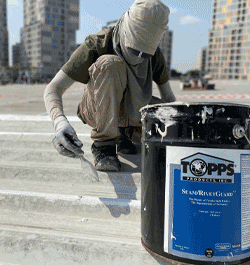UP TO THE MINUTE
Enhancing ergonomic safety for roofers

By Cotney Consulting Group.
Mastering the quick exposure check (QEC) to prevent work-related musculoskeletal disorders
As roofing contractors, your job demands physical strength and endurance, but it also comes with its fair share of risks, especially regarding work-related musculoskeletal disorders (WMSDs). Protecting your team from these hazards is not just a matter of compliance; it's about ensuring their well-being and the efficiency of your operations. One valuable tool in this regard is the quick exposure check (QEC), a comprehensive assessment developed by the University of Surrey (UK) that focuses on the four body areas most susceptible to WMSDs. This article will explore how to effectively use the QEC to enhance safety within your roofing contracting business.
How to use an ergo risk assessment: Understanding the QEC process
Implementing an ergo risk assessment, such as the QEC, begins with clearly understanding the process. The QEC assesses exposure in crucial body areas: the back, shoulders, arms and legs. By evaluating these areas, you gain valuable insights into the potential risk factors your workers face daily. To conduct a QEC, start by identifying the tasks your team performs regularly, focusing on repetitive movements, heavy lifting or awkward postures.
Next, observe your workers in action and use the QEC guidelines to score each task based on the level of risk it poses to the specified body areas. The assessment considers factors like force, duration, frequency and posture. Each factor is assigned a score, allowing you to quantify the risks accurately. This systematic approach enables you to pinpoint high-risk activities and concentrate your efforts where they are needed most.
How to provide justification for making improvements: Utilizing QEC results
Once you have conducted the QEC assessment, you will have a detailed report highlighting the areas needing improvement. However, effectively presenting these findings is crucial to garnering support for necessary changes within your roofing contracting business. When discussing the QEC results, focus on the assessment's data-driven insights. Quantify the risks, emphasizing the potential consequences of untreated WMSDs, such as lost workdays, decreased productivity and increased medical costs.
Use these concrete statistics to make a compelling case for investing in safety measures and ergonomic improvements. Highlighting the financial implications can resonate with stakeholders, emphasizing that proactive investments in worker safety can now save significant costs. Additionally, it emphasizes the positive impact on employee morale and job satisfaction, which can lead to increased productivity and reduced turnover rates.
How to prioritize tasks based on scores: Implementing proactive safety measures
Armed with the QEC results, you can prioritize tasks based on their scores to implement targeted safety measures. Focus your attention on high-risk activities that received elevated scores in the assessment. Identify feasible solutions and interventions to mitigate the risks associated with these tasks. This could involve implementing mechanical aids for heavy lifting, providing ergonomic tools and equipment or redesigning work processes to minimize awkward postures.
Collaborate with your team to develop and implement these solutions, ensuring everyone understands the changes and actively participates in the safety initiatives. Regular training sessions can reinforce proper techniques and create a culture of safety consciousness among your workers. Addressing high-risk tasks promptly and comprehensively reduces the likelihood of WMSDs among your roofing contractors, fostering a safer and more efficient work environment.
Ensuring the safety and health of roofing contractors is not just about reducing the incidence of accidents on the job — it's also about minimizing the risk of musculoskeletal disorders, which can arise from repetitive tasks and improper ergonomics. With the insights from the QEC, you can continue making data-driven decisions to improve your team's working conditions.
Creating an action plan from QEC scores
After prioritizing the tasks based on the QEC scores, creating a detailed action plan is the next critical step. This plan should list the high-priority areas, the proposed improvements and a timeline for implementation. Here's how to approach it:
- Develop a list of interventions: For the highest-scoring tasks, develop specific interventions. This could include the purchase of safety equipment, changes in work practices or the introduction of rest breaks to reduce the duration of exposure to certain tasks.
- Set clear objectives and timelines: Define what success looks like for each intervention. For instance, reducing the QEC score for a particular task from 'high' to 'medium' risk within six months can be a measurable objective.
- Allocate resources: Ensure a budget and personnel are allocated for implementing the interventions. The involvement of top management in this step is crucial for securing the necessary resources.
- Engage the workers: The people doing the work best understand the tasks and how they might be improved. Involve them in planning and implementing solutions to ensure practical and effective changes.
- Monitor and review: After implementing changes, reassess the tasks using the QEC to ensure the risk level has decreased. Continuous monitoring allows for adjustments to be made as needed.
The importance of training and continuous improvement
Training is paramount to ensure that roofing contractors understand the best practices to minimize ergonomic risks. Regular training sessions on proper lifting techniques, the use of ergonomic tools and the importance of taking scheduled breaks are essential. Furthermore, fostering a culture where workers are encouraged to report discomfort or suggest improvements can lead to early interventions and prevent the development of WMSDs.
Continuous improvement should be the mantra when it comes to ergonomic safety. As new tools and techniques become available and your workforce and workload evolve, so should your approach to managing ergonomic risks. Keep abreast of industry best practices and regularly review your QEC assessments to ensure your safety measures are current and effective.
The roofing industry is inherently demanding, but by using tools like the quick exposure check (QEC), contractors can significantly reduce the risk of WMSDs. By conducting thorough risk assessments, justifying improvements with solid data, prioritizing interventions based on QEC scores, creating a robust action plan and committing to training and continuous improvement, roofing businesses can protect their most valuable assets — their workers. Remember, an investment in ergonomics is an investment in your business's sustainability and your team's health and productivity.
Learn more about Cotney Consulting Group in their Coffee Shop Directory or visit www.cotneyconsulting.com.


















Comments
Leave a Reply
Have an account? Login to leave a comment!
Sign In